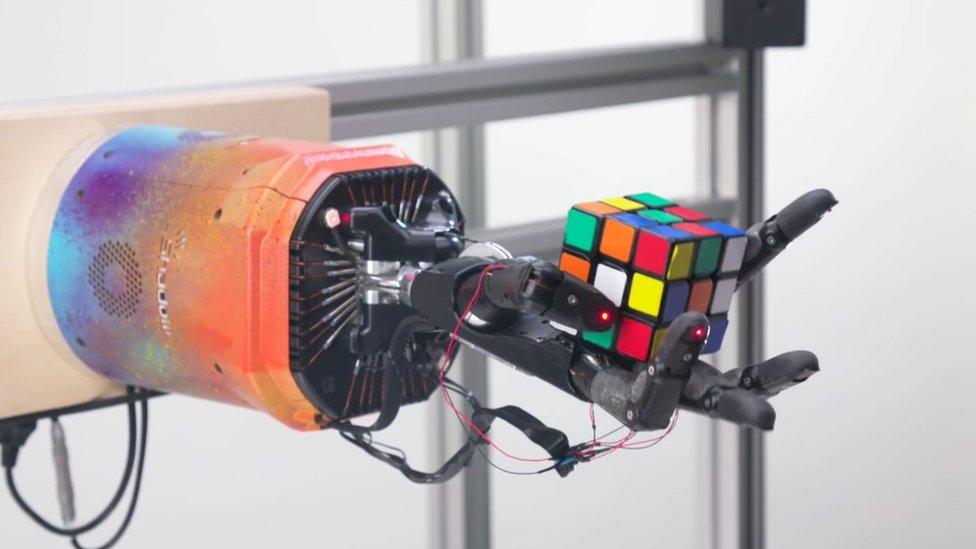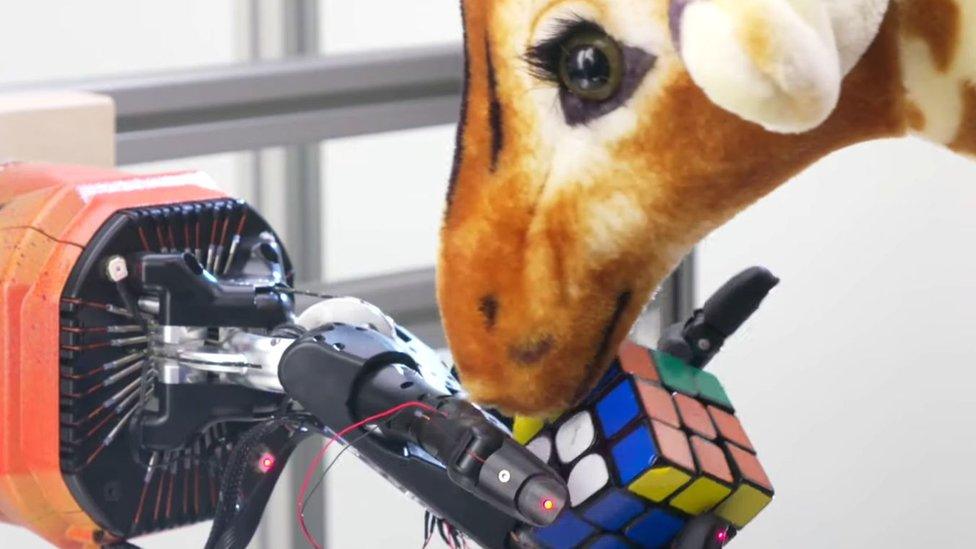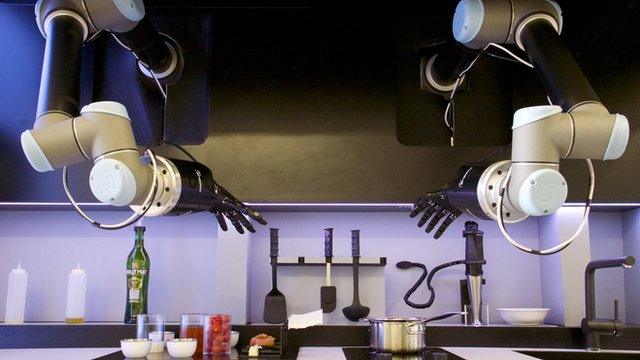Robot hand solves Rubik’s cube, but not the grand challenge
- Published

The robot hand took, on average, around four minutes to solve the Rubik's cube
A remarkable robot, capable of solving a Rubik’s cube single-handedly, has demonstrated just how far robotics has advanced - but at the same time, experts say, how far we still have to go.
OpenAI’s system used a computer simulation to teach the robot hand to solve the cube, running through routines that would take a single human some 10,000 years to complete.
Once taught, the robot was able to solve a cube, external that had been slightly modified to help the machine tell which way up it was being held.
Completion time varied, the research team said, but it generally took around four minutes to complete the task.
Using machine-learning and robotics to solve a Rubik’s cube has been achieved before. Notably, in March 2018, a machine developed by engineers at MIT managed to solve a cube in just 0.38 seconds, external.
What’s significant with OpenAI’s effort is the use of a multi-purpose robot, in this case a human-hand-like design, rather than a machine specifically designed to handle a Rubik’s cube and nothing else.
“The ability to solve the Rubik’s cube in the real world, on a robot hand, is actually extremely difficult,” said Matthias Plappert, team leader for robotics at OpenAI, speaking to the BBC.
“You need to very precisely control your fingers, you need to do it for a very long time without kind of messing up in between. and a lot of different things can happen in the process.”
Mr Plappert hailed the team’s method of gradually injecting complications into the process - simulated hindrances that would force the robot to adapt in order to complete the cube.
This technique - called automatic domain randomisation (ADR) - was used, the team said, to give the robot consistent, intricate dexterity that can handle changes in the environment that go beyond what a computer could predict and simulate.
'Showmanship'
In a demonstration video posted on Tuesday, external, OpenAI demonstrated how adding difficulty for the robot - such as nudging the cube with a giraffe stuffed toy, or covering the cube with a black sheet - did not necessarily prevent the completion of the cube (though the hand did not have a 100% record, researchers said).
While instinctive to humans, handling disruptions or complications, particularly when dealing with holding and manipulating objects, is seen as a grand challenge of robotics - a problem that will need to be solved if advanced robotics are to become commonplace in every home and business.
“We use human hands for all kinds of things,” said Peter Welinder, also a team leader at OpenAI.
“We use them to solve Rubik’s cubes, but we also use them for cooking meals. This is one of the reasons we picked the robotic hand, because it promises much more general purpose robots.

The team interjected with mild disturbances to the robot to see if it was able to handle unexpected incidents
“The big obstacle has been manipulation. So we took the Rubik's Cube as an example of really how far can we push manipulation.”
But, argues Prof Ken Goldberg from UC Berkeley, OpenAI’s research should not be overstated, despite being what he described as an impressive act of “showmanship”.
“The average human isn't particularly good at solving Rubik’s cubes,” he told the BBC.
“So when they see a robot doing it, they say, ‘well, this is better than a human’. But that's a little deceptive - because games are not reality.”
He said OpenAI’s ADR technique was genuine progress, but handling items more complex and unpredictable than a Rubik’s cube will require more research.
“Will we get to the point where a robot could pick up a deck of cards and shuffle them like a Las Vegas croupier? Or anyone who's reasonably good at doing that? That could be 10-20 years off.
“We’re far from being able to replace kitchen workers who chop up vegetables, or even pick up and you know, do dishwashing. All those are very complex tasks.”
The BBC has not been able to independently verify the performance of OpenAI’s robot. And, while details were not disputed by the experts the BBC spoke to, OpenAI’s research paper, external was not peer-reviewed.
OpenAI was announced in October 2015, co-funded by Tesla chief executive Elon Musk, start-up specialist Sam Altman and other investors (though Mr Musk is no longer involved). Its goal was to further research in artificial intelligence, with a focus on a technique known as "reinforcement learning" - teaching AI with repetitive tasks and "rewards" for correct outcomes. OpenAI is seen as a key competitor to Google's Deepmind.
_____
Follow Dave Lee on Twitter @DaveLeeBBC, external
Do you have more information about this or any other technology story? You can reach Dave directly and securely through encrypted messaging app Signal on: +1 (628) 400-7370
- Published14 April 2015
- Published14 April 2015

